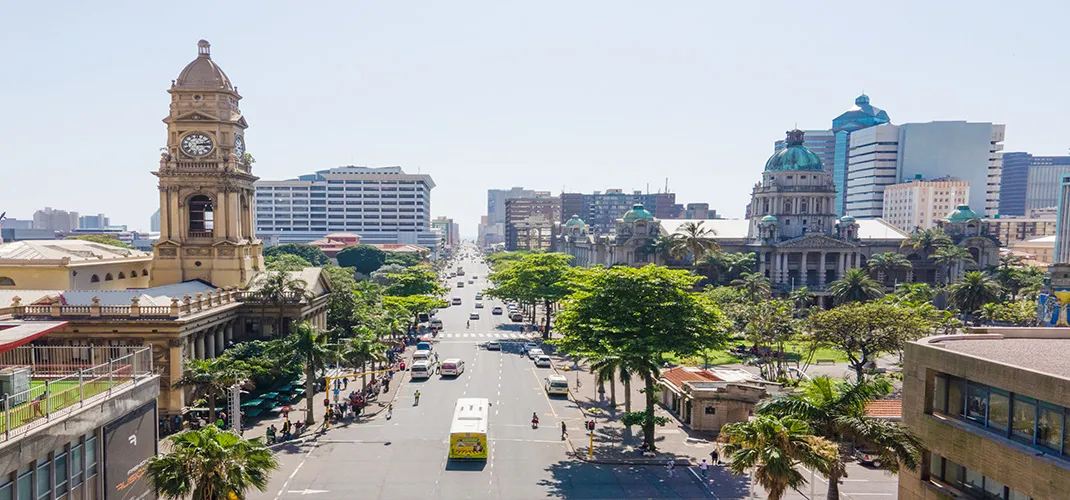Durban

Durban is located on South Africa’s East Coast. This Port City has been built around a string of long and attractive sandy beaches and the warm waters of the Indian Ocean. Durban is South Africa’s third largest city and has a fusion of natural and manmade sights, museums and a superb cuisine.
The Golden Mile is the best place to head to in Durban. It stretches from the centre of the CBD to several beaches along with an attractive promenade filled with wonderful cafés and restaurants. Like most of the Golden Mile’s beaches, South Beach is patrolled by lifeguards most of the year. It has a quieter atmosphere making it a great choice for families. Neighbouring North Beach is better known for its waves, which attracts surfers and bodyboarders from all over the world.
The Moses Mabhida Stadium was built for the 2010 FIFA Soccer World Cup and was named after a leading anti-apartheid politician. It not only hosts football games but also cricket and rugby union. The arch spans the 55,000 seater arena and incorporates a 550 step ‘adventure walk’ leading to a viewing platform 106 metre above the ground. There’s also a funicular to reach the top for those who cannot handle the walk. Beyond the views of Durban and the Indian Ocean, the platform provides the perfect spot to watch daredevils throwing themselves from the arch on the bungee swing, which throws them 220 meters across the pitch.
KwaMuhle Museum is the most important and most interesting of all Durban’s exhibition spaces. This Museum of Apartheid has been sensitively situated in the building once hated by non-white South Africans, the Department of Native Affairs. It was here that the passes, which had to be carried by everyone entering the city were issued. Today, the Museum details all this with its collection of documents, photographs, videos and items belonging to ordinary South Africans. The KwaMuhle Museum plays a fundamental role in educating the generations born after the release and election of Nelson Mandela as South Africa’s first Black President.
Durban’s Botanic Gardens is the oldest formally laid out gardens in South Africa, which dates back to 1849. It has a mixture of both local South African plants and exotics plants from around the world and displays specimens from a variety of floral kingdoms including Orchids and Palms. There is also a English style sunken garden displaying a colourful array of flowers, a butterfly habitat garden and a naturally fed lake.
Cuisine is one of Durban’s big draw cards being it is one of South Africa’s most ethnically diverse cities. Durban’s population is made up of Zulu people in addition to a significant number of people from both British and Indian descent. The city’s oceanic location means there is always a variety of fish on the menu whether it be a deep fried British style or something covered in flavoursome spices originating from the Indian subcontinent. A dish that is specific to the city is Bunny Chow, a curried mixed vegetable stew traditionally served in a hollowed out loaf of bread.
Durban’s Natural Science Museum with its grand columned exterior is a museum that attracts a lot of visitors. It is part of Durban City Hall and focuses on the living planet, the museum is a treasure trove of stuffed animals, birds and mammals to insects and reptiles. Its exhibits also display as far as ancient Egypt with the mummy known as Peter Amen and one of the most complete skeletons of a Dodo.
Other Museums worth visiting include the Old Court House Museum, built in 1860, it houses a collection of over 10,000 items telling the story of the area and its people. The building was regularly frequented by Mahatma Gandhi while he acted as a lawyer in the city.
The Phoenix Settlement, just north of the CBD, was bought by Gandhi in 1904. It was here that he began the switch from lawyer to freedom fighter. The settlement acted as a test bed for a series of ideas, from communal living to the policy of non-violence, which would see Gandhi unsuccessfully nominated for a Nobel Peace Prize on more than one occasion. The house where Gandhi lived during this time has been fully restored and can be visited as part of the Inanda Heritage Trail.
Once a water filled quarry, the Umgeni River Bird Park now has tropical flora spanning 3.5 hectares on the opposite Bank of the Umgeni River to the City. It is home to approximately 800 birds coming from over 200 species including some that are the only examples of their kind in Africa.
